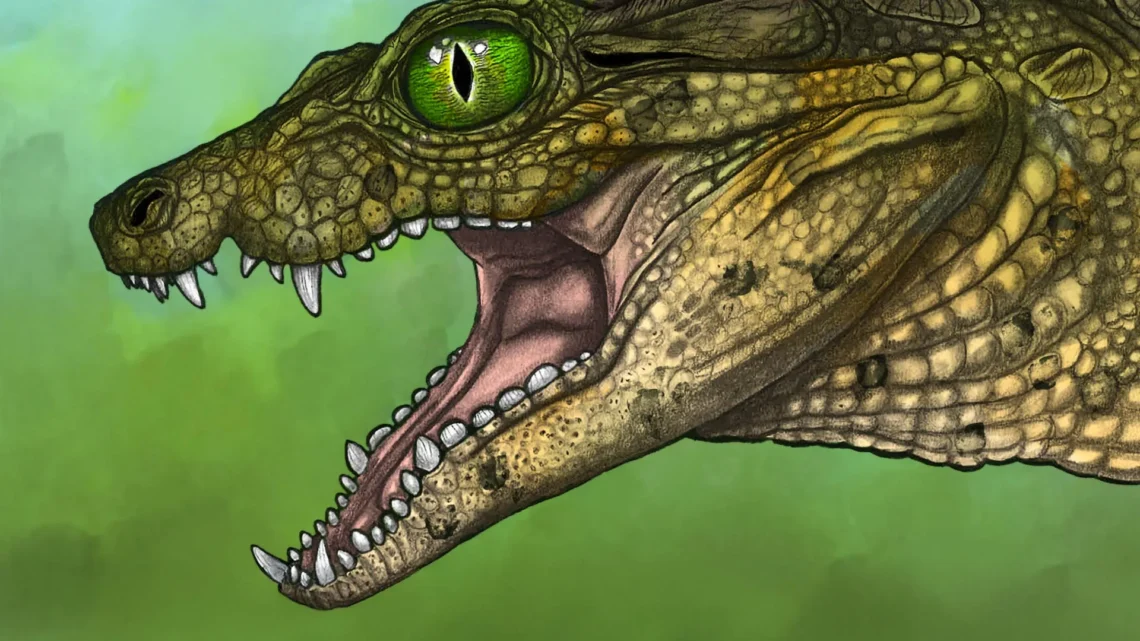About 95 million years ago, a young crocodile-like creature nicknamed Elton roamed southwest Montana, near the Western Interior Seaway.
Measuring only about 2 feet from nose to tail, Elton was roughly the size of a large lizard, according to David Varricchio, a professor of paleontology at Montana State University. If it had reached adulthood, Elton would have grown to a maximum length of 3 feet—quite small compared to most members of the Neosuchia clade, which includes modern crocodiles and their closest extinct relatives, most of which were semi-aquatic or marine carnivores with simple, cone-shaped teeth.
Elton, however, lived on land and probably fed on both plants and small animals, thanks to its array of specially shaped teeth. Its unique anatomy indicates it belonged to a new family of crocodyliforms that thrived in Cretaceous North America.
Thanks to the keen observation skills of Harrison Allen, a 2023 graduate from MSU’s Department of Earth Sciences, Elton’s remains might have remained undiscovered. During a dig in the summer of 2021 at the Blackleaf geological formation near Dillon, Allen—then a student in Varricchio’s field paleontology course—spotted a fossil about the size of a pinkie fingertip with an unusual texture.
“I brought it to Dr. Varricchio, knowing it had to be something important, since he said, ‘Take me to where you found this,'” Allen recounted. He is now pursuing croc paleontology as a doctoral student at Stony Brook University in New York.
This was an exhilarating moment for Allen, who originally hails from Kentucky. He chose MSU for its undergraduate track in paleontology within the earth sciences. Now, after four years and countless hours of study, he is the lead author of a paper recently published in the Journal of Vertebrate Paleontology, revealing key findings about the creature whose remains he discovered in the Blackleaf Formation.
“After the dig, Dr. Varricchio explained why he was so thrilled on the day I found the initial specimen. There was so much visible anatomy to explore, and he recognized it as a tiny, fully articulated croc skull—an exceptional find,” Allen said. “Although we’ve found dinosaurs in the Blackleaf before, this was just the second known vertebrate animal discovered in this formation.”
The extinct creature, now named Thikarisuchus xenodentes, provided new insights into the paleoecology of the Blackleaf ecosystem and the evolutionary history of the croc family tree.
Additionally, it presented an incredible undergraduate research opportunity for Allen, who meticulously excavated, sifted, and reconstructed the Thikarisuchus remains with fellow students’ assistance.
“As a nervous undergraduate new to research, I approached Dr. Varricchio and expressed my desire to study this specimen,” Allen said. “It led me on a fascinating journey through the world of prehistoric crocs and their evolutionary adaptations.”
The day after finding the initial skeleton piece, Allen and his classmates collected sediment from the site. Back in Bozeman, he and his colleague Dane Johnson, a 2022 graduate and now a paleontology specialist at MSU’s Museum of the Rockies, dedicated 10 to 20 hours sifting through fine particles to uncover dozens of small fragments of the Thikarisuchus skeleton—enough to fit in the palm of Allen’s hand. As they worked, they listened to music, including Elton John’s hit “Crocodile Rock,” leading to the enduring nickname “Elton,” even before it received its official scientific name, highlighting its physical characteristics.
Allen and Johnson recovered bone fragments from nearly every part of the creature, such as its limbs, vertebrae, jaw, and 50 mm skull. Given the tiny size and fragility of the fragments, they decided against physically reassembling them. Instead, they opted for CT scans, including some at MSU’s Subzero Research Laboratory. Allen estimates he spent over 100 hours color-coding the digital slices produced by the scans, a crucial step for distinguishing the bones from the surrounding rock.
“Harrison worked extremely hard on digitally reconstructing the animal, and the result was stunning,” praised Varricchio.
During this process, Allen found that the bones of Thikarisuchus were densely packed and arranged similarly to fossils of other organisms found in burrows in the Blackleaf and nearby Wayan formations in Idaho. This suggests that Thikarisuchus was likely preserved in a burrow, reinforcing the idea that fossils found in these formations mainly represent those that were preserved in such environments.
The specimen also offered clues about Thikarisuchus’ newly defined family, Wannchampsidae, and a related group known as Atopasauridae found in Eurasia. Both groups were small and adapted to terrestrial life, sharing similar cranial and dental features with another distantly related group from the Cretaceous period in Africa and South America.
“This suggests that during the same time, we see convergent evolution between two unrelated groups due to similar environment and prey availability, prompting crocs on opposite sides of the planet to develop analogous traits,” Allen explained.
As he continues toward his Ph.D. and aims to become a paleontology professor, Allen shared how his experiences with Elton have solidified his research focus, which has expanded to include extinct crocs worldwide.
“Most of the diversity in crocodyliforms is historical. There were fully marine, terrestrial, herbivorous, and omnivorous crocs, as well as some that cracked shells,” he noted. “This revelation inspired me to delve deeper into this captivating area of paleontology.”
Varricchio expressed gratitude for students like Allen who choose to study at MSU, saying, “It was a genuine pleasure to have Harrison here—his enthusiasm and dedicated research were truly remarkable.”
Summary: About 95 million years ago, a juvenile crocodyliform known as Elton lived in what is now Montana. Discovered by student Harrison Allen, Elton, now scientifically named Thikarisuchus xenodentes, reveals insights into the paleoecology of its time and the evolution of its family. Allen’s research led to significant findings, highlighting the varied adaptations of ancient crocs and inspiring a new generation of paleontologists.




